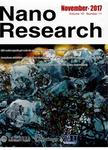Intracellular in situ labeling of Ti02 nanoparticles for fluorescence microscopy detection
Intracellular in situ labeling of Ti02 nanoparticles for fluorescence microscopy detection作者机构:Department of Radiation Oncology Feinberg School of Medicine Northwestern University Chicago Illinois 60611 USA X-ray Science Division Advanced Photon Source Argonne National Laboratory 9700 South Cass Avenue Argonne Illinois 60439 USA Department of Physics & Astronomy Weinberg College of Arts and Sciences 2145 Sheridan Road Evanston Illinois 60208 USA
出 版 物:《Nano Research》 (纳米研究(英文版))
年 卷 期:2018年第11卷第1期
页 面:464-476页
核心收录:
学科分类:0808[工学-电气工程] 0809[工学-电子科学与技术(可授工学、理学学位)] 081705[工学-工业催化] 08[工学] 0817[工学-化学工程与技术] 0805[工学-材料科学与工程(可授工学、理学学位)] 0803[工学-光学工程] 0702[理学-物理学]
基 金:supported by the National Institutes of Health supported by NIH ARRA supported by NCI CCSG P30 CA060553 support of NIH supported by the U.S. Department of Energy, Office of Science, Office of Basic Energy Sciences supported by NASA Ames Research Center supported by the U.S. Army Research Office the U.S. Army Medical Research and Materiel Command Northwestern University funding received from the Soft and Hybrid Nanotechnology Experimental (SHyNE) Resource
主 题:TiO2 nanoparticles anatase Click reaction biotin-streptavidin synchrotron X-ray fluorescence microscopy
摘 要:Titanium dioxide (TiO2) nanoparticles are produced for many different purposes, including development of therapeutic and diagnostic nanoparticles for cancer detection and treatment, drug delivery, induction of DNA double-strand breaks, and imaging of specific cells and subcellular structures. Currently, the use of optical microscopy, an imaging technique most accessible to biology and medical patholog36 to detect TiO2 nanoparticles in cells and tissues ex vivo is limited with low detection limits, while more sensitive imaging methods (transmission electron microscopy, X-ray fluorescence microscop~ etc.) have low throughput and technical and operational complications. Herein, we describe two in situ post- treatment labeling approaches to stain TiO2 nanoparticles taken up by the cells. The first approach utilizes fluorescent biotin and fluorescent streptavidin to label the nanoparticles before and after cellular uptake; the second approach is based on the copper-catalyzed azide-alkyne cycloaddition, the so-called Click chemistry, for labeling and detection of azide-conjugated TiO2 nanoparticles with alkyne- conjugated fluorescent dyes such as Alexa Fluor 488. To confirm that optical fluorescence signals of these nanoparticles match the distribution of the Ti element, we used synchrotron X-ray fluorescence microscopy (XFM) at the Advanced Photon Source at Argonne National Laboratory. Titanium-specific XFM showed excellent overlap with the location of optical fluorescence detected by confocal microscopy. Therefore, future experiments with TiO2 nanoparticles may safely rely on confocal microscopy after in situ nanoparticle labeling using approaches described here.



